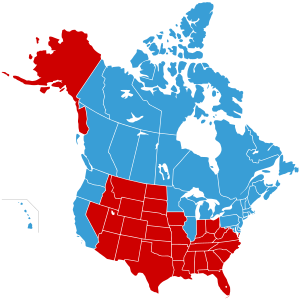Jesusland map

The Jesusland map also known as Dumbfuckistan is an Internet meme, created shortly after the 2004 United States Presidential election, which satirizes the red/blue states scheme by dividing the United States and Canada into "The United States of Canada" and "Jesusland".[1]
Origin
The original image was created on November 3, 2004 by G. Webb, a poster on yakyak.org, an Internet message board for fans of the work of Jeff Minter (see the original discussion). It quickly became an internet meme, which The New York Times described as an "instant Internet classic".[2]
Geography
The meme is in the form of a map of the U.S. and Canada which depicts a new hypothetical national border between the two countries. The "blue states" from the 2004 election have been merged with Canada to form a single contiguous nation, which is labeled the "United States of Canada." The remaining "red states" are labeled as "Jesusland". The Freakonomics blog opined that the map reflected the "despair, division, and bitterness" of the 2004 election.[3]
Variations

Similar maps give different labels to the geographically separated blue states. The northeastern states are alternately referred to as "Eastern Realitania", "Northeastistan", "Western France", "The New American Republic", or "New America";[4] the central blue states near the Great Lakes are labeled "Central Realitania" or "Minniwillinois"; and the blue states along the Pacific Coast are called "Western Realitania", "Pacificstan", "Southern Canada" or "Baja Canada" (with Hawaii being separately labeled "The Tropic of Canada"). Another has chosen the overall name "Realistan", and another has chosen "The United States of Liberty and Education". The red states in these variant maps are called "Jesusistan", "Redstateistan", "Redneckistan",[4] the "United States of Evangelicals",[5] "the United State of Texas", or in the most extreme case, "Dumbfuckistan" (referenced by a December 18, 2004 TV Funhouse cartoon on Saturday Night Live[6]). Some maps purport to show a capital city of Crawford, Texas, the home of former U.S. President George W. Bush. One map shows Alaska as having been returned to Russia.
The Canadian province of Alberta, which has historically voted for the Conservative Party of Canada or its antecedents,[7] is sometimes included in Jesusland and is contiguous with the continental U.S. "red" states.
A future polity entitled the "Republic of Northern America" is posited as a result of disenchantment and growing irritation between the Northern and Southern U.S. states, leading the former to seek a union with Canadian provinces.[8]
Analysis

In the context of the Jesusland map, the states in which a majority voted Democratic in the 2004 election are viewed as more socially liberal in outlook, and therefore having more cultural similarities with Canada than with the remainder of the United States. The Republican-voting red states tended to vote based more on Christian moral values, such as opposition to same-sex marriage and embryonic stem cell research.[9] Holders of these values are characterized by a high degree of faith in Evangelical Christianity, thus causing the name of Jesus to be affixed to the hypothetical country;[10] in an article by Ron Suskind of the New York Times, a Republican official characterized the divide as being one between a "faith-based community" and a "reality-based community".[11]
The gap is seen as stark enough that some Democratic bloggers have sarcastically or semi-seriously advocated secession, while some on the Republican side (such as Mike Thompson, a past chairman of the Florida American Conservative Union) suggested that the federal government expel the blue states.[12] To that end, some have noted the similarity between the electoral map of the U.S. in 2004 and a map of the United States in 1860, showing the free and slave states prior to the American Civil War.[13][14]
See also
- Bible belt
- Canada and the 2004 United States presidential election
- Nine Nations of North America
- Soviet Canuckistan
References
- ^ Matt Bai (November 19, 2006). "The Last 20th-Century Election?". The New York Times Magazine. Retrieved 13 December 2009.
Since Bush's disputed victory in 2000, many liberals have been increasingly brazen about their disdain for the rural and religious voters; one popular e-mail message, which landed in thousands of Democratic in-boxes in the days after the 2004 election, separated North America into "The United States of Canada" and "Jesusland."
- ^ Jack Hitt (December 12, 2004). "Neo-Secessionism". The New York Times Magazine. Retrieved 13 December 2009.
A proposed map showing the United States of Canada just above JesusLand has become an instant Internet classic.
- ^ Mengisen, Annika (November 9, 2009). "Maps: Fighting Disease and Skewing Borders". Freakonomics blog, from The New York Times. Retrieved 13 December 2009.
{{cite news}}: Italic or bold markup not allowed in:|publisher=(help) - ^ a b http://vegasmusictalk.com/images/usa3waysplit.gif
- ^ Muslim WakeUp! A Possible Solution to US Electoral Problems[dead link]
- ^ Posted by D (2004-02-29). "Media Sluts: Drunken Weekend, Lotsa O.C". Mediasluts.blogspot.com. Retrieved 2010-05-24.
- ^ "Alberta: NDP ends Tory dominance". Nationalpost.com. 2008-10-14. Retrieved 2010-05-24.
- ^ Kelly, Stéphane. "The Republic of Northern America." Toronto Star; Opinion (Canada 2020). 26 December 2006.
- ^ "Exit poll - Decision 2004 - MSNBC.com". MSNBC. 2004-10-27. Retrieved 2010-05-24.
- ^ "Weblog: 'Moral Values' Carry Bush to Victory | Christianity Today | A Magazine of Evangelical Conviction". Christianity Today. Retrieved 2010-05-24.
- ^ Suskind, Ron (2004-10-17). "Faith, Certainty and the Presidency of George W. Bush". The New York Times. Retrieved 2010-05-06.
- ^ "Human Events". Humaneventsonline.com. Retrieved 2010-05-24.
- ^ http://archive.michiganimc.org/usermedia/image/7/large/election%202004%202%20maps%202f6760.JPG
- ^ "essays & effluvia: Voting: Free versus Slave States". Bigpicture.typepad.com. Retrieved 2010-05-24.
